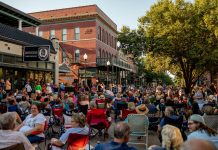Each year on March 17, Ireland’s patron saint leads the Dougherty family through the streets of Dogtown on a flatbed truck. The Doughertys, decked out in matching sweatshirts, pin shamrocks with their names all over their float, adding more names over the years.

Since 1986, the St. Louis Ancient Order of the Hibernians (AOH), an Irish Catholic fraternal organization, has held its St. Patrick’s Day parade in Dogtown. The parade unites Irish families to celebrate heritage, history and Catholicism, while highlighting the neighborhood’s Irish roots.
Next year, AOH media representative Jim Mohan said the St. Louis AOH will hold a special celebration to honor the 40th anniversary of the St. Patrick’s Day parade, as well as the 140th anniversary of the St. Louis Hibernian division.
Peggy Dougherty Porter first attended the parade in 1992 with her immediate family after her friend, Jim Mohan, sparked the Doughertys’ interest in marching as a clan.
Mohan, media representative for the St. Louis AOH, has marched with his family since the first Hibernian parade in 1984, before it moved to Dogtown in its third year.
Mohan and Porter return each St. Patrick’s Day for the parade, and the Dougherty clan now includes extended family and friends. Although they occasionally miss a member or two, the Doughertys have never skipped the Hibernian parade.
“Every year, we look forward to it because we think it’s better than Christmas because everybody’s there. They’re not at somebody else’s house or party,” Porter said about the parade. “I took my kids out of school starting in grade school, high school [to be there]. They’d come home from college to be in the parade. They take off work now. It’s the day for the Doughertys to celebrate.”
The Hibernians schedule their parade around St. Louis’ other St. Patrick’s Day celebration: the downtown parade, which takes place the weekend before the holiday. Although the Hibernian and downtown parades used to exist as one celebration, the two parades split in 1984, according to George Clough, who was national president of the AOH at the time of the parades’ split.
While the AOH wanted its St. Patrick’s Day celebration centered around Irish families and the Catholic faith, the downtown parade committee wanted to have a more general holiday celebration.
“Irish people and clans would rather march in the Hibernian parade because there’s just more room to express themselves, and there’s more going on,” Clough said. “Both of them are good parades, but as past national president of the AOH, if both of them are on the same day, I certainly am marching in the Hibernian parade in Dogtown.”
The first AOH parade took place in Clayton in 1984, then in Hazelwood the following year. The parade finally settled in Dogtown in 1986 with the support of St. James the Greater Parish, an Irish Catholic church on Wade Avenue that acts as Dogtown’s cultural hub.
John Corbett, president of the Dogtown Historical Society, said the parade has been a treasure to the Dogtown business district, and residents love the event because it gives them a chance to celebrate their Irish values.
Corbett said the parade moved to Dogtown because other areas were unable to accommodate weekday parade traffic, and the predominantly Irish Dogtown welcomed the celebration with open arms.
“Irish are very fun-loving people. They believe in ‘craic’ … It’s an Irish-Gaelic word that means having fun, just go out and have a good time,” Corbett said. “We have the ability to be optimistic because not much bad happens here. That’s the truth because most of the people [in Dogtown] were raised average, whether they’re Irish or not … We don’t have any rich people in Dogtown. We spend the money, we have fun.”
The annual AOH parade begins with mass at St. James the Greater Parish, which was built

in Dogtown in 1860 to provide a social structure for the growing Irish Catholic population in Dogtown. Reverends traveled from Ireland to share the “Irish way” with Irish immigrants in St. Louis.
Author and vice president of production at Nine Network Patrick Murphy sought to find the meaning of the “Irish way” in his book, “The Irish in St. Louis: From Shanty to Lace Curtain.” He said the Irish have held their values close throughout history, and their determination and culture deserves to be celebrated by the whole community.
“What does it mean [to be Irish]? It might mean that you tell stories. It might mean that you are not averse to having a drink. It might mean that you have a way with words. Maybe central to your culture is Catholicism,” Murphy said. “I came to the conclusion that [being Irish] means whatever you want it to mean. If you’re only barely Irish but really like the idea of being Irish, go ahead and be Irish.”
Corbett said these values of love and freedom are prominent in the neighborhood today, and when he visited Ireland with his brother years ago, he said it felt like he had just spent a month in Dogtown.
“Everybody [in Ireland] was the same as people here, no matter what nationality they are. So it’s more or less in their blood. And it’s been passed down to generation after generation until now,” Corbett said. “And the only people that are still learning are the people who just moved here, and they’re getting it pretty quick from everybody else, they understand that. So, it don’t take long to be Irish.”
At next year’s anniversary celebration, the parade’s four remaining founders hope to make a special appearance, including George Clough. The celebration will once again honor the “Irish way” that shapes Dogtown.
“There are a lot of people who live in Dogtown but aren’t Irish. It’s just an atmosphere, a vibe, a color,” Murphy said. “[There’s] a feeling that you get from that town is very unpretentious. It’s not trying to be Irish. It just simply is.”
Share this post
Molly Foust (she/her) spring 2023 Editor-In-Chief.




